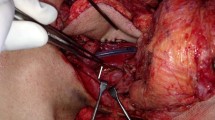Abstract
Pharyngocutaneous fistula (PCF) is the most cumbersome complication after salvage total laryngectomy (STL) in patients who have been previously irradiated for laryngeal or hypopharyngeal cancer. To assess the fistula rate, risk factors and effects of primary closure with and without pectoralis major myofascial interposition flap (PMMIF) on fistula formation, we conducted a retrospective review. We identified 48 patients from 2004 to 2013 who underwent STL after failure of primary curative (chemo)radiotherapy in laryngeal or hypopharyngeal cancer. Details of risk factors for PCF formation, other postoperative complications and general outcome data were analyzed. Ten (20.8 %) out of 48 patients underwent STL with PMMIF closure. Patient and tumor features were not different between the groups with or without PMMIF closure. PCF rates were 0 and 42.1 % in patients with and without PMMIF, respectively (p = 0.002). Other operative complications were similar. We identified prior neck irradiation to be a risk factor for fistula formation (p = 0.04). Patients without PCF had a statistically significant reduction of average hospital stay (20 vs. 56 days; p = 0.001). Analysis of fistula management revealed 50 % of PCF to be closed secondarily by a pectoralis major myocutaneous flap. Over one-third of fistulae persisted despite attempted surgical closure in some cases. PMMIF is useful to prevent PCF in STL following (chemo)radiotherapy. Neck irradiation during primary treatment is a risk factor for PCF formation.



Similar content being viewed by others
References
Forastiere AA, Goepfert H, Maor M et al (2003) Concurrent chemotherapy and radiotherapy for organ preservation in advanced laryngeal cancer. N Engl J Med 349:2091–2098
Pfister DG, Spencer S, Brizel DM et al (2014) Head and neck cancers, Version 2.2014. Clinical practice guidelines in oncology. J Natl Compr Cancer Netw 12:1454–1487
Wolf G, Hong K, Fisher S, The Department of Veterans Affairs Laryngeal Cancer Study Group et al (1991) Induction chemotherapy plus radiation compared with surgery plus radiation in patients with advanced laryngeal cancer. N Engl J Med 324:1685–1690
Weber RS, Berkey BA, Forastiere AA et al (2003) Outcome of salvage total laryngectomy following organ preservation therapy: the Radiation Therapy, Oncology Group trial 91-11. Arch Otolaryngol Head Neck Surg 129:44–49
Sassler AM, Esclamado RM, Wolf GT (1995) Surgery after organ preservation therapy: analysis of wound complications. Arch Otolaryngol Head Neck Surg 121:162–165
Fung K, Teknos TN, Vandenberg CD et al (2007) Prevention of wound complications following salvage laryngectomy using free vascularized tissue. Head Neck 29:425–430
Patel U, Moore B, Wax M et al (2013) Impact of pharyngeal closure technique on fistula after salvage larynectomy. JAMA Otolaryngol Head Neck Surg 139:1156–1162
Khan N, Medina J, Sanclement JA, Krempl GA (2014) Fistula rates after salvage laryngectomy: comparing pectoralis myofascial and myocutaneous flaps. Laryngoscope 124:1615–1617
Avey CME, Gandhi N, Peel D, Neal CP (2014) Indications and outcomes for 100 patients managed with a pectoralis major flap within a UK maxillofacial unit. Int J Oral Maxillofac Surg 43:546–554
Paydarfar JA, Birkmeyer NJ (2006) Complications in head and neck surgery: a meta-analysis of postlaryngectomy pharyngocutaneous fistula. Arch Otolaryngol Head Neck Surg 132:67–72
Paleri V et al (2014) Vascularized tissue to reduce fistula following salvage total laryngectomy: a systematic review. Laryngoscope 124:1848–1853
Gilbert MR, Sturm JJ, Gooding WE, Johnson JT, Kim S (2014) Pectoralis major myofascial onlay and myocutaneous flaps and pharyngocutaneous fistula in salvage laryngectomy. Laryngoscope 124:2680–2686
Myers E (1972) The management of pharyngocutaneous fistula. Arch Otolaryngol 95:10–17
Kruse A, Luebbers H, Obwegeser J, Bredell M, Gratz K (2011) Evaluation of the pectoralis major flap for reconstructive head and neck surgery. Head Neck Oncol 3:12
Sundaram K, Wasserman J (2009) Prevention of unplanned pharyngocutaneous fistula in salvage laryngectomy. Otolaryngol Head Neck Surg 141:645–647
Calli C, Pinar E, Oncel S (2011) Pharyngocutaneous fistula after total laryngectomy: less common with mechanical stapler closure. Ann Otol Rhinol Laryngol 120:339–344
Gil Z, Gupta A, Kummer B et al (2009) The role of pectoralis major muscle flap in salvage total laryngectomy. Arch Otolaryngol Head Neck Surg 135:1019–1023
McLean J, Nicholas C, Duggal P et al (2012) Surgical management of pharyngocutaneous fistula after total laryngectomy. Ann Plast Surg 68:442–445
Oosthuizen J, Leonard D, Kinsella J (2012) The role of pectoralis major myofascial flap in salvage laryngectomy: a single surgeon experience. Acta Otolaryngol 132:1002–1005
Righini C, Lequeux T, Cuisnier O, Morel N, Reyt E (2005) The pectoralis myofascial flap in pharyngolaryngeal surgery after radiotherapy. Eur Arch Otorhinolaryngol 262:357–361
Basheeth N, O’Leary G, Sheahan P (2014) Pharyngocutaneous fistula after salvage laryngectomy: impact of interval between radiotherapy and surgery, and performance of bilateral neck dissection. Head Neck 36:580–584
Patel U, Keni S (2009) Pectoralis myofascial flap during salvage laryngectomy prevents pharyngocutaneous fistula. Otolaryngol Head Neck Surg 141:190–195
Aarts M, Rovers M, Grau C, Grolman W, van der Heijden G (2011) Salvage laryngectomy after primary radiotherapy: what are prognostic factors for the development of pharyngocutaneous fistulae? Otolaryngol Head Neck Surg 144:5–9
Author information
Authors and Affiliations
Corresponding author
Ethics declarations
Conflict of interest
The authors declare no conflict of interest.
Research involving human participants
All procedures performed in this study involving human participants were in accordance with the ethical standards of the institutional, regional and national research committee and with the 1964 Declaration of Helsinki and its later amendments or comparable ethical standards.
Informed consent
For this type of study, formal consent is not required.
Rights and permissions
About this article
Cite this article
Anschütz, L., Nisa, L., Elicin, O. et al. Pectoralis major myofascial interposition flap prevents postoperative pharyngocutaneous fistula in salvage total laryngectomy. Eur Arch Otorhinolaryngol 273, 3943–3949 (2016). https://doi.org/10.1007/s00405-016-4049-7
Received:
Accepted:
Published:
Issue Date:
DOI: https://doi.org/10.1007/s00405-016-4049-7



